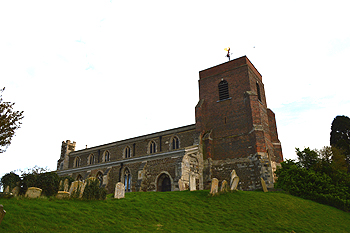Early Education in Shillington

The church from the north-west March 2014
The history of education in Shillington is much longer than in most parishes in the county. The first reference to a schoolmaster, whose name was Creeke, was in 1578 [ABC1]. Churchwardens' accounts have references to repairs to the schoolhouse between 1583 and 1601 [P44/5/1]. It is not known where this schoolhouse was but Trinity College Cambridge, Lords of the Manor of Shillington Rectory since 1547 seem to have overseen it as their archive holds a letter from a man named John Davy in 1647 enquiring about being schoolmaster. In the 1870s the school managers asked the rector if school classes could be held in the church, because the new schools were full and because "a School had been formerly held in the church" though this may have been no more than an assumption.
Schoolmasters Edward Jennings and Lancelot Granger were buried in 1697 and 1705 respectively. Volume 81 published by Bedfordshire Historical Records Society (2002) is a series of episcopal visitations undertaken in the first twenty years of the 18th century, edited by former County Archivist Patricia Bell. At each visitation a list of questions was sent out in advance, one of which enquired about the provision of schools in each parish. Surprisingly the bishop's visitations of 1709, 1712 and 1720 all flatly declare there was no school. Despite this we know schoolmaster John Cook's wife was buried in 1730. This suggests that the school was sporadic or had packed up on the death of Lancelot Granger only being revived after 1720. The last reference to a schoolmaster in the 18th century is to William Wilmer whose children were baptised between 1753 and 1757.
In 1818 a Select Committee was established to enquire into educational provision for the poor. This was no doubt prompted, in part, by the recent foundation of two societies promoting education and specifically the building of schools. The Society for Promoting the Lancasterian System for the Education of the Poor was established in 1808 promoting schools run along the lines pioneered by Joseph Lancaster, who had himself copied those of Dr.Andrew Bell, in which older children taught their younger fellows. The Society was renamed the British and Foreign School Society in 1814,. It was supported by a number of prominent nonconformists, Lancaster himself was a Quaker, and sought to teach a non-sectarian curriculum. In answer to this perceived nonconformist takeover of local education the National Society was formed in 1811 to encourage the teaching of poor children along Anglican lines, including the catechism. The Select Committee sent a questionnaire to all parishes in the country asking for: particulars relating to endowments for the education of children; other educational institutions; observations of parish needs etc. Shillington reported a Sunday School consisting of 140 children "who are instructed by three masters and a mistress at a salary of £5 per annum each raised by voluntary subscription. In those days a Sunday School was just that, a school which met on a Sunday, usually in the church or nonconformist chapel or other similar building, teaching more than the religious topics with which they are associated today. There was now no daily school - if there ever had been as there is no reference to the earlier school being daily and that may explain the negative referencesin the episcopal visitations). The vicar John Hull noted: "The children of the labouring classes being employed in making straw plat, it is rather doubtful whether a weekly school would be well attended, but it is the opinion of the minister that great utility might be derived from a school of industry".
In the country generally the number of schools built continued to grow over the next fifteen years so that by 1833 the government agreed to supplement the work of the two societies, and local benefactors, by making £20,000 per annum available in grants to help build schools. It also prompted another questionnaire to be sent to each parish in England asking for details of local educational provision. Shillington, with its hamlets of Lower Stondon and Holwell reported three Sunday schools, two consisting of 47 males and 41 females and supported by subscription from which the master and mistress received £4 per annum and the other, with 15 boys and 14 girls, wholly supported by George Musgrave who gave a yearly salary of £4 to the master.
The next national enquiry was in 1846/7 when the Church of England made an enquiry as to all its church schools. This was against the background of a new Whig government which championed secular education and the increasing importance of nonconformists, particularly Wesleyan Methodist, and Roman Catholics in providing schools. Shillington's Sunday school now catered for 61 boys and 73 girls. The vicar wrote: "The educational wants are very great. There is no building of any kind adapted for a Daily school. The most part of the population are unable to read and write their names. A school, if established, might be in a measure self-supporting". In 1847 in a newspaper article about the church John Martin stated that there was: "no school but one established by Dissenters".
That school was established in 1856 as a National School, for which plans survive [AD3865/39]. The site was behind old almshouses. The new buildings could accommodate 120 children and comprised two schoolrooms, one for boys and one for girls according to the plan [AD3865/39].

The old junior school March 2014